Related Research Articles
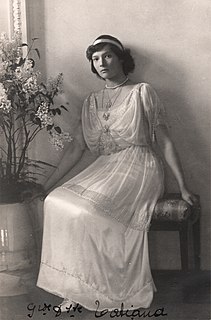
Grand Duchess Tatiana Nikolaevna of Russia was the second daughter of Tsar Nicholas II, the last monarch of Russia, and of Tsarina Alexandra. She was born at Peterhof, Saint Petersburg.
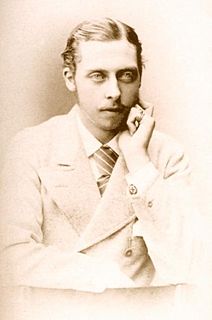
Prince Leopold, Duke of Albany, was the eighth child and youngest son of Queen Victoria and Prince Albert. Leopold was later created Duke of Albany, Earl of Clarence, and Baron Arklow. He had haemophilia, which led to his death at the age of 30.
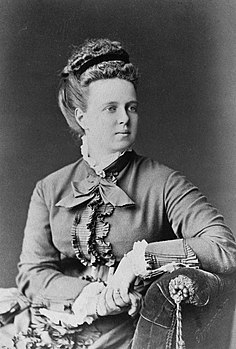
Grand Duchess Maria Alexandrovna of Russia was the fifth child and only surviving daughter of Emperor Alexander II of Russia and his first wife, Princess Marie of Hesse and by Rhine. She was the younger sister of Alexander III of Russia and the paternal aunt of Russia's last emperor, Nicholas II.

Grand Duke Dmitri Pavlovich of Russia was a son of Grand Duke Paul Alexandrovich of Russia, a grandson of Tsar Alexander II of Russia and a first cousin of Tsar Nicholas II.

Princess Alexandra of Saxe-Coburg and Gotha, VA, CI was the fourth child and third daughter of Alfred, Duke of Saxe-Coburg and Gotha and Grand Duchess Maria Alexandrovna of Russia. As the wife of Ernst II, she was Princess consort of Hohenlohe-Langenburg. She was a granddaughter of both Queen Victoria of the United Kingdom and Tsar Alexander II of Russia.

Maria Alexandrovna, born Princess Marie of Hesse and by Rhine was Empress of Russia as the first wife and political adviser of Tsar Alexander II. She was one of the founders of the Russian Red Cross.

Grand Duchess Elena Vladimirovna of Russia, sometimes known as Helen, Helena,Helene,Ellen,Yelena,Hélène, or Eleni, was a Russian grand duchess as the only daughter and youngest child of Grand Duke Vladimir Alexandrovich of Russia and Duchess Marie of Mecklenburg-Schwerin. Her husband was Prince Nicholas of Greece and Denmark and they were both first cousins of Emperor Nicholas II of Russia. She was also first cousin of Queen Juliana of the Netherlands and Alexandrine of Mecklenburg-Schwerin, Queen Consort of Denmark.
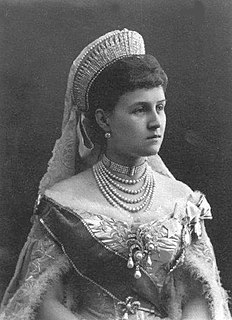
Princess Alexandra of Greece and Denmark ; 30 August [O.S. 18 August] 1870 – 24 September 1891), later known as Grand Duchess Alexandra Georgievna of Russia, was a member of the Greek royal family and of the Russian imperial family. She was the daughter of George I of Greece and Olga Constantinovna of Russia. She died of childbirth complications.

Grand Duke Paul Alexandrovich of Russia was the sixth son and youngest child of Emperor Alexander II of Russia by his first wife, Empress Maria Alexandrovna. He was a brother of Emperor Alexander III and uncle of Nicholas II, Russia's last monarch.
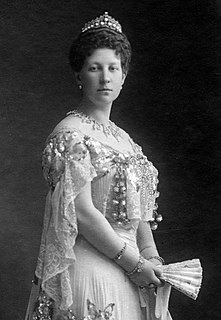
Princess Maria of Greece and Denmark was a daughter of King George I of Greece and his wife Grand Duchess Olga Constantinovna of Russia. She was a sister of King Constantine I of Greece and a first cousin of Tsar Nicholas II of Russia.

Grand Duke Vladimir Alexandrovich of Russia was a son of Emperor Alexander II of Russia, a brother of Emperor Alexander III of Russia and the senior Grand Duke of the House of Romanov during the reign of his nephew, Emperor Nicholas II.

Princess Helen of Serbia and Yugoslavia was a Serbian princess, the daughter of King Peter I of Yugoslavia and his wife Princess Zorka of Montenegro. She was the elder sister of George, Crown Prince of Serbia and King Alexander I of Yugoslavia. Helen was also a niece of Anastasia of Montenegro, wife of Grand Duke Nicholas Nikolaevich of Russia, and of Milica of Montenegro, wife of Grand Duke Peter Nicolaievich of Russia, the women who introduced Grigori Rasputin to Tsarina Alexandra.

Grand Duchess Maria Pavlovna of Russia, known as Maria Pavlovna the Younger, was a granddaughter of Alexander II of Russia. She was a paternal first cousin of Nicholas II and maternal first cousin of Prince Philip, Duke of Edinburgh.
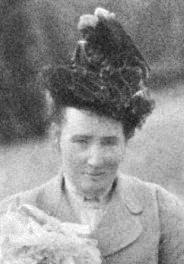
Margaretta Alexandra Eagar, was an Irishwoman who served as a nanny to the four daughters of Emperor and Empress Nicholas II and Alexandra Feodorovna of Russia, the Grand Duchesses Olga; Tatiana; Maria; and Anastasia—known collectively as OTMA—from 1898 to 1904.
Princess Vera Constantinovna of Russia, also Vera Konstantinovna, was the youngest child of Grand Duke Konstantine Konstantinovich of Russia and his wife, Grand Duchess Elizabeth Mavrikievna. A great-granddaughter of Tsar Nicholas I of Russia, she was born in the Russian Empire and was a childhood playmate of the younger children of Emperor Nicholas II of Russia. She lost much of her family during World War I and the Russian Revolution. At age twelve, she escaped revolutionary Russia, fleeing with her mother and brother George to Sweden. She spent the rest of her long life in exile, first in Western Europe and from the 1950s in the United States.

Princess Alexandrine of Baden was the Duchess of Saxe-Coburg and Gotha as the wife of Ernest II. She was the eldest child of Leopold, Grand Duke of Baden, and his wife Princess Sophie of Sweden.

Princess Marina Petrovna of Russia was a daughter of Grand Duke Peter Nikolaevich of Russia and his wife, Grand Duchess Militza Nicholaevna, born Princess of Montenegro. A great-granddaughter of Tsar Nicholas I of Russia, she was born in Nice and grew up in the last period of Imperial Russia, mostly in Znamenka, her father's summer palace near Peterhof.

Princess Nina Georgievna of Russia,, was the elder daughter of Grand Duke George Mikhailovich and Grand Duchess Maria Georgievna of Russia. A great-granddaughter of Tsar Nicholas I of Russia, she left her native country in 1914, before World War I finished her education in England and spent the rest of her life in exile. In London in 1922, she married Prince Paul Chavchavadze, a descendant of the last king of Georgia. They had one child, Prince David Chavchavadze, born there two years later. In 1927 the family of three moved to the United States and settled in New York. In 1939 they bought a home in Wellfleet, Massachusetts. Princess Nina was an artist, her husband worked as an author; he wrote five books and translated several others. Their son, Prince David Chavchavadze, served with the U.S. Army during World War II and, thanks in part to his knowledge of Russian, eventually became a CIA officer. After his retirement, he wrote his memoirs and published those of his grandmother, Grand Duchess George, as well as a book about the grand dukes of Russia.
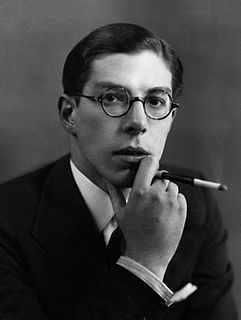
Prince Vsevolod Ivanovich of Russia was a male line great-great-grandson of Tsar Nicholas I of Russia and a nephew of King Alexander I of Yugoslavia. He was the last male member of the Romanov family born in Imperial Russia. He was a distant cousin and godson of Tsar Nicholas II of Russia, as well as second cousin of Prince Philip, Duke of Edinburgh and Princess Marina, Duchess of Kent.

Princess Elizabeth Charlotte Alexandra Mary Louise of Hesse-Kassel, was a Princess of Hesse-Kassel by birth and, by her marriage to Leopold, Hereditary Prince of Anhalt, the Hereditary Princess of Anhalt.
References
- 1 2 3 "Charlotte Zeepvat". Charlotte-zeepvat.co.uk. Retrieved February 19, 2012.
- ↑ Historical research for university degrees in the United Kingdom, List No. 35, Part 1: Theses completed 1973 (University of London Institute of Historical Research, 1973), p. 53: "Patrons and collectors in early Stuart England. 1254 Charlotte M. Zeepvak [ sic ] (Dr E. W. Ives) Birmingham M.A."
- ↑ Zeepvat, Charlotte (1976). "Art collecting and artistic patronage in early Stuart England, with particular reference to the function of the ambassador". University of Birmingham. ProQuest 301393806.Cite journal requires
|journal=(help)(subscription required) - 1 2 3 4 "Charlotte Zeepvat: Biography". Charlotte-zeepvat.co.uk. Retrieved February 19, 2012.
- 1 2 Arnstein, Walter L. (2000). "Book Reviews: Europe". The Historian . 62 (2): 466.
- ↑ Zeepvat, Charlotte (1998). Prince Leopold: The Untold Story of Queen Victoria's Youngest Son. Sutton Publishing Limited. p. vii.
- ↑ Kahlenberg, Cynthia (May 22, 2009). "A Royal Shame: Prince Leopold's Hemophilia and Its Effect on Medical Research". Dartmouth College . Retrieved March 2, 2012.
- ↑ Morrissy, Mary (August 19, 2000). "Twinkle, twinkle, little tsars Romanov Autumn: Stories from the Last Century of Imperial Russia. By Charlotte Zeepvat. Sutton Publishing. 287pp, (pounds) 19.99 in UK: [CITY EDITION]". The Irish Times . ProQuest 309283739.(subscription required)
- ↑ Freeman, Jay (2000). "Romanov autumn: Stories from the last century of imperial Russia". Booklist . 17 (96): 1648. ProQuest 235458611.(subscription required)
- ↑ A.C.T. (Spring 2007). "From Cradle to Crown: British Nannies and Governesses at the World's Royal Courts". The Contemporary Review . 289: 135.
- ↑ Zeepvat, Charlotte (February 13, 1998). "Letter: 'Lost' Prince John". The Independent . Retrieved February 19, 2012.
- ↑ Zeepvat, Charlotte (August 18, 1998). "Historical notes: The prince and the autograph album". The Independent . Retrieved February 19, 2012.
- ↑ Dennison, Matthew (May 14, 2006). "Nurse to her darlings, spy to their mothers". The Daily Telegraph . Retrieved February 19, 2012.